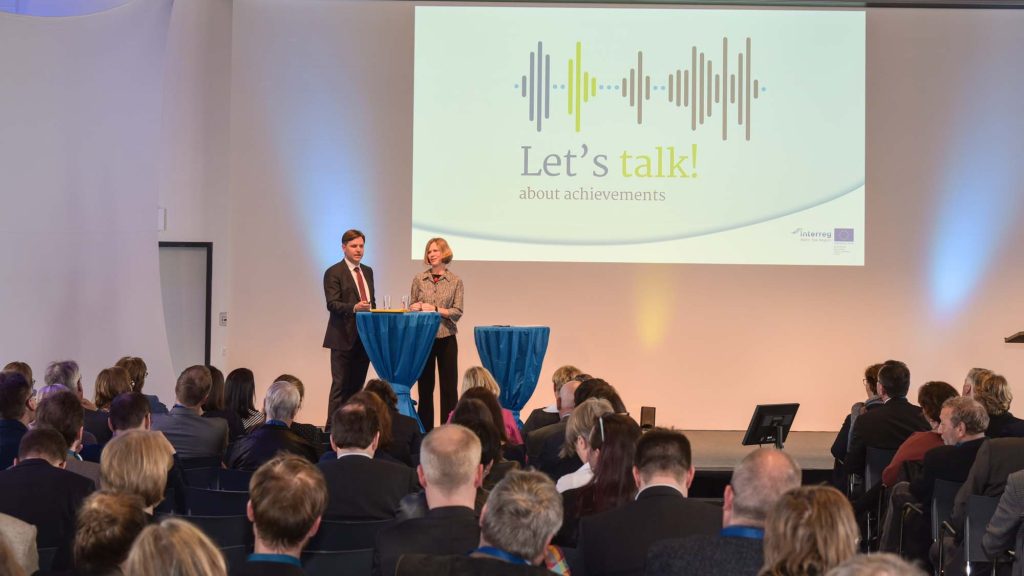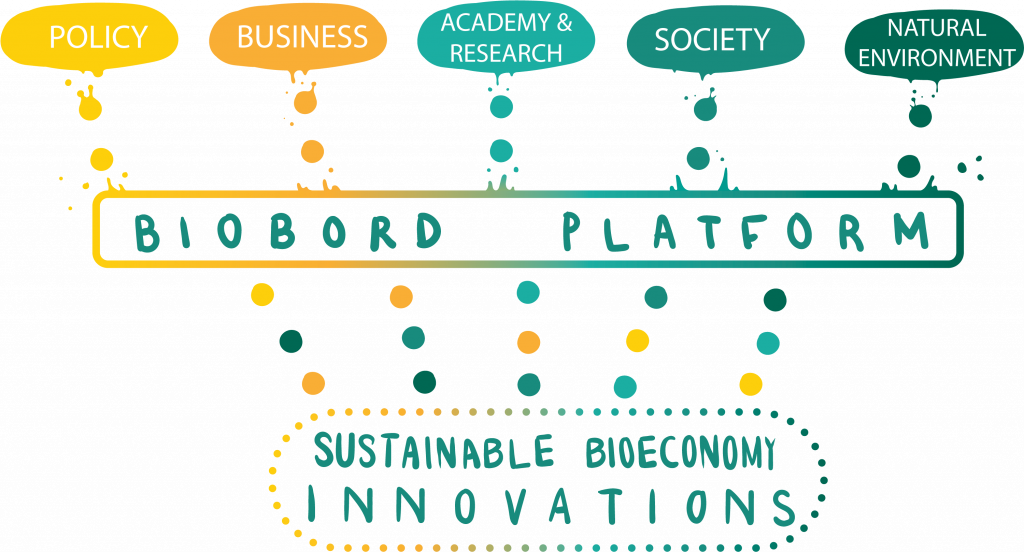Defending Rural Bioeconomy against the Dragons

Confessions from the Dragon’s Den
When I initially signed up for presenting the RDI2CluB project in the Interreg BSR Conference ‘Let’s talk achievements’ organized in Lübeck in April 2019, I expected (and prepared for) a standard project presentation for a room of fellow project leaders with interest areas in bioeconomy and circular economy. As it was later revealed, the format was something else entirely. A dragon’s den – or lion’s den as we call it in Finland – where the presenters would give a pitch in 10 minutes without any materials to a panel of experts representing stakeholders and monitoring committees of the Interreg BSR funding programme. Although we already have our funding secured, we would defend our projects against representatives of funders with inquiries ranging from our contributions to sustainable use of natural resources to the relevance of transnational co-operation within BSR.
Pro-tip for anyone who has to do the same. Practice your timing. Ten minutes is literally nothing, especially when your project actions range from regional strategy work to piloting international online platform for innovation management to boost rural bioeconomy development in Baltic Sea Region. Nevertheless, a fun experience and I do recommend the workshop model as a dynamic and interactive alternative to the standard project presentations.
I admittedly did not manage to summarize enough, but still would like to share our ‘pitch’ with you to tell the story behind the exhausting name and complex acronym that is ‘Rural RDI milieus in transition towards smart bioeconomy clusters and innovation ecosystems’ – RDI2CluB.
Untapped potential in rural bioeconomy around the Baltic Sea
As stated in the EUSBSR Policy Area Bioeconomy, the Baltic Sea Region has the potential to become one of the world’s leading regions in green growth and sustainable development. We have a well-developed infrastructure, strong knowhow and skilled workforce and a large concentration of biomass. It is foreseen that bioeconomy creates new development in rural areas and offers opportunities to grow primary industries. In short, bioeconomy should create new business opportunities and knowledge based jobs for the rural areas of the Baltic Sea Region that are currently suffering from de-population, brain drain and unfavorable demographic transition.
However, this is not yet happening. The transformation of the rural areas to a knowledge-based bioeconomy seems to be slow and a lot of the economic benefits of bioeconomy transition actually focus to urban agglomerations rather than the rural regions with the biomass resources. In fact herein lies the problem, the transition requires capacity to change, learn and innovate which is more prevalent where clustering of business, research, start-ups and knowledge-based industries occurs. In rural regions, we simply lack creative connections between people from different fields of expertise and this decreases innovation potential significantly.
The rural SMEs need to build their ability to learn and innovate in the transforming markets. Many sectors have not yet embraced the potential of bioeconomy or circular economy, nor the fast moving digital world, even though their clients may already be there. The pressure for change is rising with diversification of customer needs and with entry of new competition from global and unexpected origins. Capacity to learn and to innovate is vital for renewal of business models and uptake of innovations in SMEs to pave the way to sustainable and inclusive economic development.
Forerunners from Central Finland
In RDI2CluB, our mission is to help the rural regions of the Baltic Sea realize their potential in bioeconomy development – to see more jobs and positive economic progress in the rural areas. To highlight the potential, I want to give you two examples of creating added-value for biomass from our home region, Central Finland.
First, Jukola Industries, a company that can sell a wooden board with a price up to 3,000 Euros, a 100-folds value added. A one-of-a-kind wood cutting process based on algorithm based design programming produces unique 3D wood elements for interior and exterior panels offering customized fixtures for wood architecture. Secondly, a local start-up, B’Drone that turns bee drone larvae, a side product of honey production that usually has gone to compost, into a sustainable food brand in co-operation with local restaurants.
What can we learn from the examples? Both these examples show, not only the added value potential of biomass, but also that the key for new innovations is connecting knowhow from different fields together. Jukola Industried connects wood construction, design and cutting-edge ICT knowhow to create something unique for their customers. B’Drones connects agriculture, circular economy models and food branding knowhow – again to create a value added experience for the customers.
Innovation Hub connects the talents and expertise
In RDI2CluB, our approach is to connect different fields of knowhow with the traditional bioeconomy business and entrepreneurs with an innovation hub. The innovation hub is a meeting place that brings together the needed talent for generating ideas and for developing the ideas further. In the innovation hub, bioeconomy start-ups can build their business plans with the help of the hub’s services and expertise. Along the innovation path, the entrepreneurs get tools and support for product development and commercialization. The testbeds, laboratories and demonstrations provide an opportunity to test and validate the products. New business ideas spark from creative encounters between people of diverse knowhow.

Innovation Hub us a platform for meeting and experimenting (Picture: Diana Pitkänen)
You may ask, how this is all possible in a lonely rural hub. In RDI2CluB, we propose it is feasible with smart co-operation regionally and inter-regionally. Digitalisation can connect local hubs together to provide a larger pool of expertise, talent and resources for bioeconomy innovation around the Baltic Sea. The connection of the hubs together is not enough, but the hubs need to build also their regional networks for capitalizing on the urban-rural connections and the bioeconomy innovation ecosystem surrounding them.
Bioeconomy campus in Saarijärvi hosts around 200 students together with the JAMK Institute of Bioeconomy and a vocational institute. In the Institute of Bioeconomy, we have about 50 experts working on RDI projects and regional development projects. However, according to our network analysis, our experts work with more than 120 organizations as well as with hundreds of SMEs and rural entrepreneurs. We plan to bridge these connections and co-working to a joint platform to create Bioeconomy Campus as a meeting place, online as well as in real life. Biobord platform offers a means to connect with other bioeconomy enthusiasts and new connections will be facilitated with matchmaking events and services.
Same process will take place in the Evenstad Innovation Centre, in Hedmark (Norway); Bioeconomy Knowledge Centre in Świętokrzyskie Voivodeship (Poland); and Latvian Food Cluster, in Vidzeme Region. All in all, our joint network potential reaches to around 550 organizations involved in supporting SMEs and start-ups with innovations in bioeconomy via innovation service related to networking, skilled workforce, expertise in RDI, supportive policy environment and capital. In addition, we can connect at least the same number of SMEs from our region from our immediate networks.

Biobord.eu connects the actors of the innovation ecosystem (Picture: Diana Pitkänen)
Putting the theory into practice with 10.5 million potential innovation cocktails
During our piloting phase starting in August 2019, we are testing Biobord with different user groups and service cases, including project lifecycle, network management, innovation calls and matchmaking, capacity building as well as connecting product and business development services. With these regional and international pilot cases, we are developing the platform and its operational model further in a user-oriented service design process. We plan to connect at least 400 bioeconomy experts to the platform via integrating our regional hubs activities to Biobord.
Let us think of the innovation potential here. As shown by the examples of Jukola Industries and B’Drones, a mix of three talents can go far in terms of innovation. If you have five talented individuals, you can build 10 types of different teams of three people. However, with 50 talents, you can already build 19 600 types of different teams of three people. As we have 400 individuals in the platform in the piloting phase, there is a potential to build more than 10.5 million different types of teams of three people.
In our network of local hubs, we can attract the talent pool to the platform by establishing it as the communication and co-working forum in projects, courses, services, events and so forth. By utilizing the forum systematically in our hubs, we can sustain a viable, growing community in the platform. In fact, our main task in RDI2CluB will be to find out the best ways to mix the talent pool, so that new combinations of expertise and creative encounters can give a rise to innovations and business opportunities. Innovation cocktails are to be served, shaken and stirred – join the party at Biobord.eu starting from August 26, 2019.
-Anna Aalto, Project Manager, JAMK University of Applied Sciences, Institute of Bioeconomy
Interreg BSR project, Rural RDI milieus in transition towards smart bioeconomy clusters and innovation ecosystems – (RDI2CluB) is co-financed by the European Regional Development Fund.